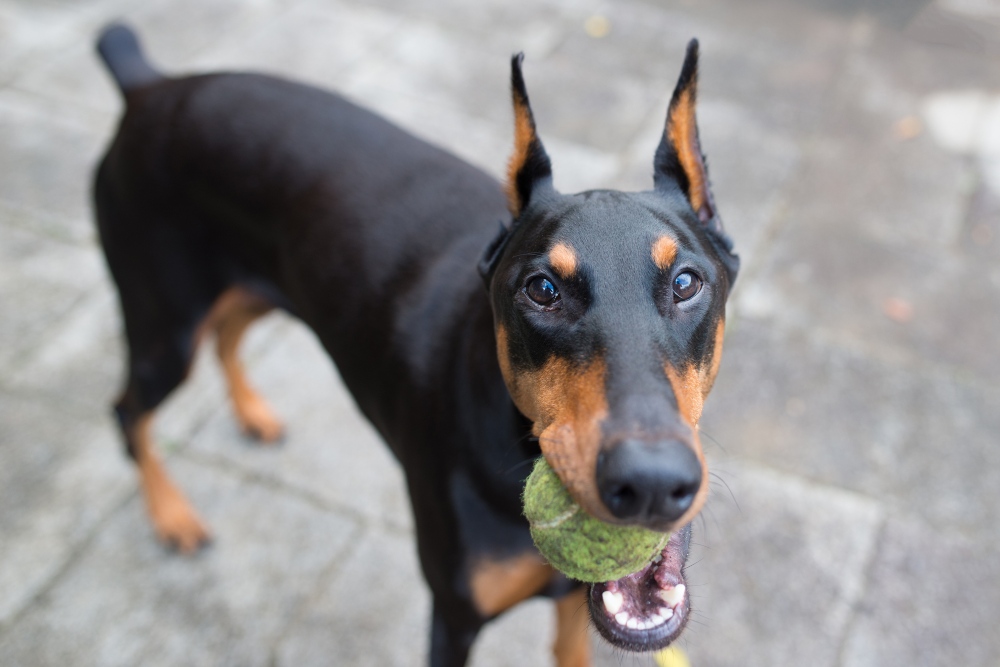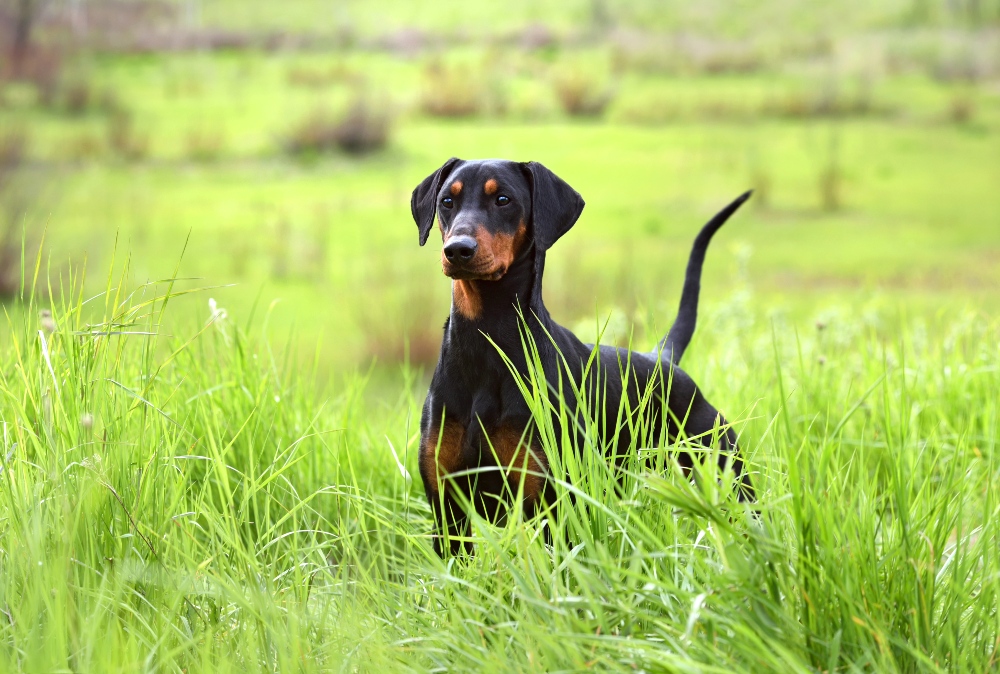Table of Contents
Introduction to Doberman Pinschers
Doberman pinschers are loyal, brave, and alert dogs that have a big size and loving hearts. This breed of dog has an impressive physique and is very sleek and powerful. The athleticism of these dogs makes them move in swift and graceful ways that are truly impressive to watch.
A Doberman pinscher will make an excellent watch dog and provide protection against intruders. This is why you will often see Dobermans working as police dogs, military dogs, and family guard dogs. Yet Doberman pinchers also develop strong bonds with their owners and will always be there for you no matter what.
Here are some things to know about Doberman pinschers if you are considering adopting or purchasing one for your household!
Size of Doberman Pinschers
A fully grown Doberman pinscher male will weigh between 75 and 100 pounds, while a fully grown female will be 60 to 90 pounds. Males reach heights of 26 to 28 inches, and females stand at about 24 to 26 inches tall. Dobermans will be done growing, in terms of both height and weight, by one year of age.
Here’s how big you can expect your Doberman pinscher to be during the first year of life:
| Weight Chart | 3 months | 6 months | 9 months | 12 months |
| Male Doberman pinschers | 29-32 lbs. | 59-60 lbs. | 74-75 lbs. | 83-84 lbs. |
| Female Doberman pinschers | 25-27 lbs. | 50-51 lbs. | 64-65 lbs. | 71-71 lbs. |
Characteristics of Doberman Pinschers
Doberman pinschers are smart, athletic, and energetic dogs that need plenty of room to move around. They are also sensitive dogs that are affectionate with family members and easy to train. Some people are intimidated by Doberman pinschers, especially ones that are not responsibly bred or properly trained. But with plenty of love, care, attention, Dobermans are amazing companions that will enrich your life every day.
As you get to know a Doberman pinscher’s personality, here’s what you can expect based on his or her breed characteristics:
| Breed Characteristic | Level (High, Medium, Low) |
| Affectionate with People | Medium |
| Good with Kids | Medium |
| Good with Pets | Low |
| Need for Exercise | Medium |
| Energy Level | Medium |
| Intelligence Level | High |
| Able to Be Trained | High |
| Amount of Barking | Low |
| Amount of Shedding | Medium |

History of Doberman Pinschers
A dog breeder by the name of Louis Dobermann is credited with the development of the Doberman pinscher breed. In the town of Apolda in Germany, he also worked as tax collector and believed that this breed would help him do his job of collecting taxes from hostile citizens while doing his rounds. The extra “n” in his last name was dropped at some point, but the dogs he began breeding were a larger and less refined version of the Doberman pinschers that exist today.
Doberman pinschers have always been known as working dogs, from tax collecting to police and military K-9 duty to guide dogs for disabled people, and search-and-rescue dogs. The breed was used by the Marines, and many lost their lives in battle during World War II. Dobermans have also worked as therapy dogs and excelled at competitive dog sports. They have strikingly good looks and a proud gait that makes them stand out and win at competitions. The American Kennel Club has recognized this breed since 1908, and the Doberman Pinscher Club of America was founded in 1921.
Doberman Pinscher Standard Information
The general appearance of a Doberman pinscher features a compact build, proud carriage, elegant appearance, and sense of nobility. Qualities used to describe Dobermans are watchful, alert, fearless, obedient, determined, and loyal. The breed standard for Doberman pinschers describes the ideal of this breed by which dogs are judged at shows and competitions.
Here is an overview of the breed standard information for Doberman pinschers:
Head:
- Long head that resembles a blunt wedge
- Almond-shaped and moderately deep-set eyes
- Ears cropped and carried erect
- Cheeks flat and muscular
- Strong and white teeth
Neck, Topline, Body:
- Neck proudly carried and well-muscled
- Tail docked at approximately the second joint
- Ribs well-sprung from the pine
- Brisket reaching deep to elbow
Forequarters:
- Shoulder blade sloping forward and downward at a 45-degree angle
- Elbow to withers height approximately equal to height from ground to elbow
- Pasterns firm and nearly perpendicular to ground
- Dewclaws may be removed
- Feet well-arched, compact, and cat-like
Hindquarters:
- Angulation of hindquarters balances that of forequarters
- Upper and lower shanks of equal length
- Dewclaws, if any, are generally removed
- Cat-like feet as on front legs
Coat:
- Smooth, short, hard, thick, and close-lying coat
- Invisible gray undercoat permissible on neck
Color:
- Black, red, blue, and fawn (Isabella) for colors
- Rust markings and white patch on chest are permissible
Gait:
- Vigorous, balanced, and free gait
- Strong rear-action drive
- Single-track when moving at a fast trot

Caring for Doberman Pinschers
To thrive, Dobermans need positive reinforcement during training and early socialization, as well as consistency in their schedules. They require patient owners who are dedicated to training and spending ample time with the dog. These are dogs that will stick by your side, but they can also develop separation anxiety if left alone for long periods of time.
Many Doberman pinscher pet parents swear by kennel training to provide a safe spot and a place of familiarity for their dogs. However, this is an active dog breed that should not be left in a kennel for more than four hours at a time.
Here are some general tips for taking the best care of a Doberman pinscher:
Best Living Environments:
- House with a fenced-in yard
- Not recommended for small apartments
- Best in homes without small children
Type of Exercise:
- Vigorous games of fetch
- Walks around the neighborhood
- Hikes and runs with family members on trails
Mental Enrichment:
- Agility and training classes
- Flyball competitions
- Playtime in a fenced-in yard
Training Strategies:
- Practice kennel training with puppies
- Start training classes early for agility, nose work, and sports
- Consider hiring a professional trainer with Doberman-specific experience
Grooming Tips:
- Low-maintenance for grooming
- Brush coat once a week
- Bathe as needed based on smell and how dirty they get
Common Health Problems of Doberman Pinschers
The life expectancy of a Doberman pinscher is 10 to 12 years. There are certain health issues that Doberman pinschers are prone to because of their breeding and genetics. If you plan to purchase a purebred Doberman from a breeder, make sure that the breeder screens dog parents for genetic diseases and can provide a health guarantee on puppies.
These are some of the most common health issues that arise with Doberman pinschers:
- Dilated cardiomyopathy (enlarged heart)
- Cervical vertebral instability (Wobbler’s syndrome)
- Von Willebrand disease (bleeding disorder)
- Gastric dilatation-volvulus (stomach expansion and twisting)
- Hypothyroidism (thyroid gland disorder)
- Progressive retinal atrophy (eye disease)
- Narcolepsy (sleep disorder)
Diet and Nutrition for Doberman Pinschers
A Doberman pinscher will need approximately 2.5 to 3.5 cups of dry dog food per day, divided into two meals. Make sure not to feed your Doberman right before or right after exercising because this breed is prone to gastric dilatation-volvulus (GDV), also known as bloat. GDV can be life-threatening and requires immediate emergency care and treatment.

Where to Adopt or Purchase Doberman Pinschers
As we already mentioned, it is very important to find a good breeder, especially if you want to adopt a pure Doberman pinscher. A good breeder can answer all of your questions about health clearances, certifications, temperament, and what these dogs are like to live with. You can start your search for a Doberman on the website of the Doberman Pinscher Club of America.
However, you may also be able to rescue a Doberman pinscher in need of a good home through websites like Petfinder.com and Adopt-a-Pet.com. The website AnimalShelter.org can help you find a Doberman to adopt, and resources are also available through the Doberman Pinscher Club of America’s rescue network.
Related Breeds
Fans of the Doberman pinscher breed may also be interested to learn about other breeds of dogs that share similar characteristics. Here are some similar and related breeds to consider before deciding whether to adopt or purchase a Doberman pinscher:
- Boxer
- German Pinscher
- Beauceron
- Rottweiler
- Miniature pinscher
- Weimaraner
- German shorthaired pointer
- Pharaoh hound
Pet Insurance for Doberman Pinschers
Regardless of whether you choose to adopt or buy a Doberman pinscher, there are certain ways that you can be proactive about your dog’s health and plan ahead for the future. Healthy Paws pet insurance gives Doberman pet parents peace of mind that they can always afford to pay for the care their dogs need.
Our Doberman pinscher insurance plan covers accidents, illnesses, cancer, emergency care, genetic and hereditary conditions, breed-specific conditions, and alternative care with speedy claim payouts and helpful customer service. Tell us just a few details about your Doberman pinscher to get your pet insurance quote today.









